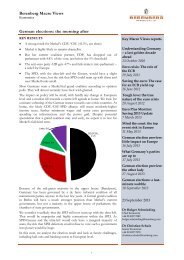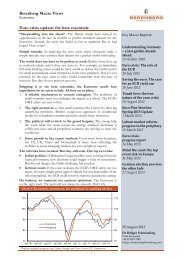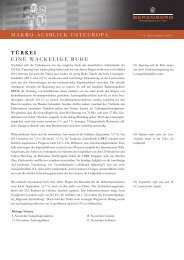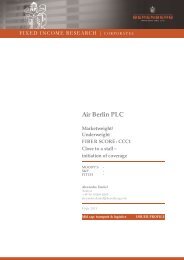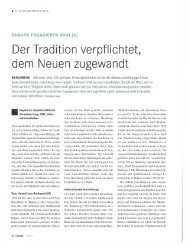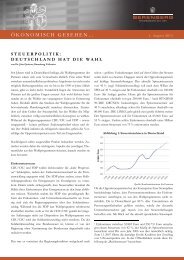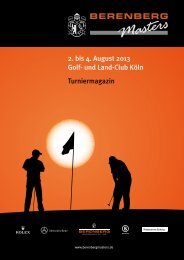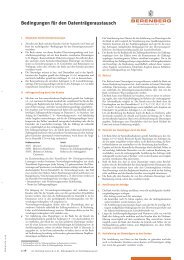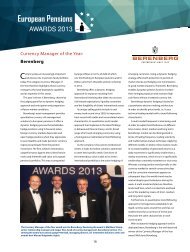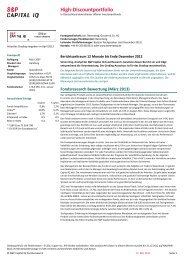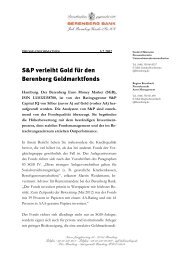Semiconductor Equipment - Berenberg Bank
Semiconductor Equipment - Berenberg Bank
Semiconductor Equipment - Berenberg Bank
You also want an ePaper? Increase the reach of your titles
YUMPU automatically turns print PDFs into web optimized ePapers that Google loves.
<strong>Semiconductor</strong> <strong>Equipment</strong><br />
Technology Hardware<br />
but to keep spending to maintain their leadership in the consumer devices<br />
market.<br />
Where are we in the cycle?<br />
We believe we are halfway into the current recovery cycle, and will enter a<br />
more muted growth phase by the end of 2013 or early 2014: ASML, AMAT,<br />
TEL, ASMI, KLA and LAM have all shown improved order intake/shipment<br />
levels from the beginning of 2013, compared to end-2012; hence, we believe we<br />
have entered a recovery cycle from the 2012 trough.<br />
We believe we may exit the recovery phase and enter a more muted growth phase<br />
of the cycle by end-2013/early 2014 for the following reasons.<br />
1) Samsung and Intel’s capex is likely to be spent in H2 and will drive order<br />
growth in H2 2013.<br />
2) TSMC, Samsung, Intel, Globalfoundries and other logic/foundry players<br />
have all budgeted higher/similar capex compared to 2012, and total logic<br />
and foundry capex is currently at a historical high (2013E: $37bn). After<br />
2013, we expect foundry/logic capex to remain at flattish until 2016. In<br />
addition, TSMC has indicated that its 2014 capex will be similar to the<br />
2013 level. We expect the solid order intake level to be maintained after<br />
2013/early 2014, but growth is likely to be muted.<br />
3) Memory spending has already picked up from the 2012 trough level since<br />
mid-2013. ASML, KLA and LAM have all indicated that memory spending<br />
is recovering. We estimate memory capex to grow at 11-15% in the next<br />
four years. However, as it only accounts for 29% of total capex, which is<br />
too small to drive significant capex hikes. Historically, memory spending<br />
used to account for up to 57% of total capex and hence had a greater<br />
impact on overall capex.<br />
Will the Apple/Samsung/TSMC/Globalfoundries shift be a zero<br />
sum game?<br />
In our view, any shift is a small positive for equipment vendors, depending<br />
on which of them Apple is shifting to: Since last year, there has been much<br />
speculation about whether Apple will shift its foundry orders from Samsung to<br />
TSMC/Intel, and whether Apple will buy fabrication plants (fabs) from United<br />
Microelectronics Corporation (UMC) or Globalfoundries. In our opinion, these<br />
shifts can be a small positive on a net basis for some equipment vendors, instead of<br />
simply a zero sum game. The new foundry is likely to build capacity which was not<br />
required previously; at the same time, the old foundry may cut its original spending<br />
level, but it may have already committed some capex as fab-building projects are<br />
multi-year projects.<br />
If Apple moves to TSMC, we believe ASML, AMAT, ASMI, and LAM will all<br />
benefit, as: 1) TSMC’s 20nm is lithography-intensive, and it only buys from ASML;<br />
2) AMAT has a strong relationship with TSMC (although the decrease in the<br />
Samsung order may have a negative impact on AMAT); and 3) TSMC 20nm is high<br />
K metal gate (HKMG)-based, which requires the ALD tool from ASMI.<br />
If Apple chooses Intel for its foundry orders, we believe TEL may benefit, with<br />
ASML also benefiting, but to a lesser extent, as 1) TEL has a close bond with Intel<br />
in relation to its etching tools, 2) AMAT does not have a strong relationship with<br />
Intel, 3) ASML may receive new orders, but it has to share Intel orders with Nikon,<br />
and 4) Intel’s capacity is 100% HKMG-based, which only leaves limited upside for<br />
ASMI.<br />
8


